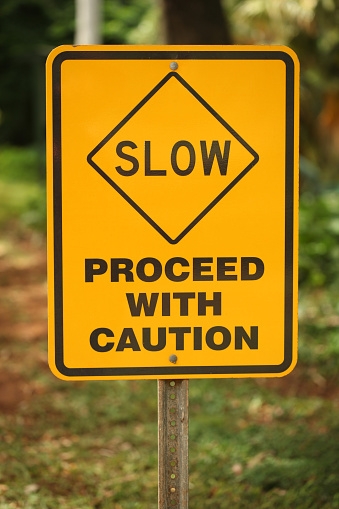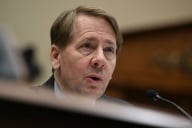You have /5 articles left.
Sign up for a free account or log in.

Getty Images
Much of the debate thus far over trigger warnings -- the flagging of specific course content that might offend or otherwise upset students -- has centered on anecdotes, some of them obviously controversial. At Oberlin College, for example, proposed trigger warning guidelines said that Chinua Achebe’s Things Fall Apart might merit a trigger warning. The idea upset many professors who said labeling it as excessively violent could undermine the experience of reading the novel. And some Columbia University students' request that Ovid’s Metamorphoses be flagged as a poem about rape earned similar criticism. Supporters of trigger warnings, meanwhile, say students learn better in an environment in which they have been warned in advance of potentially traumatic content.
Similar accounts abound. So a new survey of faculty members from the National Coalition Against Censorship regarding their actual experiences and attitudes on trigger warnings stands out. Suggesting that some 60 percent of professors view trigger warnings as damaging to academic freedom, the report quotes numerous respondents who say they've changed the way they teach to avoid offending students. "In the last two years, [I've] had students want pretty detailed and specific trigger warnings for, well, everything, which seems kind of stifling," one wrote.
Over all, educators "are deeply concerned about how trigger warnings will affect classroom dynamics and education," the report says. Quoting another surveyed professor, it says a "significant number of respondents worry that warnings essentially invite students to 'avoid engaging with uncomfortable course materials.' Indeed, this is already the experience of some respondents, like one who reports that students took the 'warning' as an excuse not to attend the class."
At the same time, the coalition’s report raises as many questions as it answers. Those include exactly where -- if anywhere -- the line between thoughtful pedagogy and chilling free speech should be drawn.
“There’s a fine line between trigger warnings and course descriptions,” said Joan Bertin, executive director of the coalition. “We saw a strong sentiment in favor of complete course descriptions. But where the dividing line is, is picking out an element of a larger work and flagging it. That’s something that people recoil against for reasons that have to do with basic pedagogy.”
Bertin added, “It distorts the content of the material and it signals something to students about an expected reaction -- but that’s a line that could be explored a lot more.”
Earlier this year, as student requests for trigger warnings popped up on a number of campuses, the coalition approached various social science and humanities professional associations about conducting a study of faculty members regarding trigger warnings. The Modern Language Association and College Art Association signed on, and some 800 of their members completed the survey. While not representative, the survey is the biggest data trove on the issue to date. And the debate has been particularly intense among those who teach literature and art.
The coalition details its major findings in a report out this week. Among them -- and to Bertin’s point -- is that many educators distinguish between trigger warnings and the more accepted practice of informing students about course content. More than half of those surveyed said they had provided “warnings about course content,” such as in a syllabus, and 23 percent said they’d done so several times or regularly. But that doesn’t mean these professors are offering what they consider to be trigger warnings -- which a majority of respondents opposed.
In open-ended responses, many professors said they drew a distinction between flagging specific elements or events in an assignment or material (what many think of as a trigger warning), and the much more general act of informing students what they’ll read, see or hear in the course. Many respondents also said they invite students to raise questions or concerns about course content with them individually.
One clear line between general warnings about course content and trigger warnings -- at least to respondents -- is making them mandatory. Professors with varying degrees of support for trigger warnings generally agreed that they should not be required or imposed by institutions, including department heads and deans. Pressure from administrators was of particular concern to respondents who identified as not tenured or as part-time, according the coalition.
So far, very few institutions have adopted formal trigger warning policies -- just 1 percent of respondents said they were required to use them. But about 8 percent said that students on their campuses have made efforts to initiate such policies, and 15 percent of respondents said students in their courses had asked for trigger warnings. Twelve percent said students complained about the absence of trigger warnings in their classes.
In one example, a student at Crafton Hills College and her parents called for several graphic novels she'd been assigned to be banned for what the student called their "shocking" sex and violence. The college initially said it would require a trigger warning policy for the books in question, but eventually dropped the idea amid criticism from faculty members and the public.
The coalition report says students see trigger warnings not just as a means of “political correctness,” but rather as applicable to a broad range of subjects across the ideological spectrum. Respondents said trigger warning requests come from students with a variety of perspectives, including sensitivity about nudity, homosexuality and religious content. Other requests relate to depictions of assault and rape, or racial or ethnic content. Others still received requests regarding content the report calls “unclassifiable,” including spiders, images of childbirth, suicide, indigenous artifacts, images of dead bodies, “fatphobia” and graphic horror film scenes.
A majority of respondents -- 62 percent -- said they believed trigger warnings have or will have a negative effect on academic freedom, and 45 percent think warnings have a negative effect on classroom dynamics. But 17 percent -- what the report calls a substantial minority -- were favorable to trigger warnings, and many of those said they see them as a sign of respect that builds trust between a professor and students, and helps students better engage with difficult material.
"[W]hen students know that you care about their well-being, they're willing to risk more, and thus they learn more," wrote one respondent.
But even some professors who reported being open to trigger warnings said they wondered how they square with important but potentially difficult course content. "While it is very important to respect survivors of sexual violence, might other students refuse to read or engage with material because it is uncomfortable or challenging?" a respondent said. "How can we teach such things as war, homophobia, racism, misogyny, and violence if we cannot expect students to read such texts or materials?"
That sentiment is similar to one expressed by the American Association of University Professors last year in its statement on trigger warnings. "Some discomfort is inevitable in classrooms if the goal is to expose students to new ideas, have them question beliefs they have taken for granted, grapple with ethical problems they have never considered, and, more generally, expand their horizons so as to become informed and responsible democratic citizens," the statement says. "Trigger warnings suggest that classrooms should offer protection and comfort rather than an intellectually challenging education. They reduce students to vulnerable victims rather than full participants in the intellectual process of education. The effect is to stifle thought on the part of both teachers and students who fear to raise questions that might make others 'uncomfortable.'"
Bertin said there was some anecdotal evidence to suggest that faculty members who identified themselves as junior or newer to the profession were more open to trigger warnings. Some said they would have appreciated such warnings in graduate school, for example. So the generational divide among faculty members on trigger warnings is worthy of further study, she said.
Greg Lukianoff, president and CEO of the Foundation for Individual Rights in Education, recently published a cover story in The Atlantic Monthly about trigger warnings and more general concerns about students distorting their own classroom experiences, as well a book called Freedom From Speech. In it he argues that students have come to expect emotional comfort at college, at the expense of real learning. Like Bertin, Lukianoff said he sensed a generational divide on trigger warnings in which current undergraduates tend to think that these warnings are “no big deal,” and may even offer them in day-to-day conversations. But the problem is that one “can’t actually guess everything someone might require a trigger warning for, putting faculty members in a kind of impossible position,” he said.
Lukianoff said that while the trigger warning debate has taken a temporary backseat to the widespread student protests over campus race relations, they’re not going away any time soon. FIRE tracks reported trigger warning requests and controversies, and they’re not slowing down. Flare-ups within the last year include those at Crafton Hills College, and at Duke University over Fun Home, Alison Bechdel’s graphic novel depicting lesbian sex. Some Harvard University law students also objected to attending classes on sexual assault law for their potential to be traumatizing.
Earlier student requests for trigger warnings include a Rutgers University at New Brunswick undergraduate's 2014 assertion that F. Scott Fitzgerald's The Great Gatsby and Virginia Woolf's Mrs. Dalloway were violent and disturbing enough, respectively, to merit trigger warnings.
Asked where general warnings about course content end and trigger warnings begin, Lukianoff said it’s not just when a college or university makes warnings mandatory, but also when students come to expect them. In that kind of environment, he said, free speech and academic freedom only can be chilled as professors question discussing any number of possible topics for fear of upsetting their students.
Erin Buzuvis, director for the Center of Gender and Sexuality Studies and a professor of law at Western New England University, moderates the Title IX Blog, which tracks on-campus sex discrimination cases. Trigger warnings aside, she said, best practice means that faculty members “should be talking and thinking about the fact that some students have trauma for all kinds of reasons that can be triggered.” It also means sharing ideas about reasonable ways to eliminate unnecessary triggers and provide warnings when appropriate, she said.
Buzuvis said that would rarely mean cutting something out of the curriculum, and that she doesn’t edit her Title IX seminar containing lots of material on sexual assault -- other than by offering a description of the course in the syllabus and avoiding cold-calling students during discussions on sensitive content. But she could think of one example in which she altered a course to avoid unnecessarily triggering students.
In her torts class, Buzuvis stopped teaching a case about plaintiff being raped in a hotel room after she opened the door to a stranger, which was presented in the reading as an example of contributory negligence, meaning the plaintiff was potentially at fault. Why drop it? There are a “million other cases that can serve as examples, and [students] don't know to expect a case about rape in the middle of our unit on defenses to negligence," she said. "So it's jarring and unnecessary -- why teach it when I can just as effectively teach that topic using a different case?”









